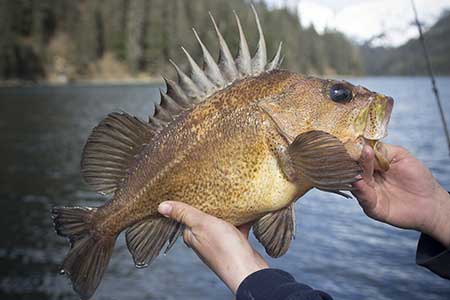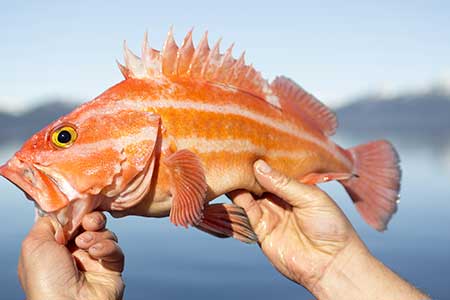Alaska Fish & Wildlife News
June 2017
Rockfish: Matrotrophically Viviparous
and Magically Delicious?

Rockfishes are long-lived marine fishes that fertilize internally, versus egg laying fish that are fertilized externally. They are also considered matrotrophically viviparous. Wait…what’s that you say? Rockfish are magically delicious?? Well yes, that too-- adult rockfish are delicious, but what is meant by matrotrophy is that many rockfish species provide a form of maternal care during embryo development where additional nutrients or energy are transferred directly to the embryo from the mother (think of something like a placenta). However, there is a high degree of variability in maternal energy contribution to embryos among species of rockfish. In addition to internal fertilization and matrotrophy, large rockfish can give live birth to MILLIONS of babies. This is where the term viviparous comes from (literally it means “giving live birth”).
Rockfish have other noteworthy life history characteristics. One is their closed (physoclistic) swim bladder. Unfortunately, this type of swim bladder cannot vent. When rockfish are caught in deep water and brought to the surface, water pressure decreases and the air in their swim bladder expands. It can expand so much it pushes the stomach out of the mouth of the fish. In some species the swim bladder ruptures. Gases dissolved in the blood also come out of solution, forming air bubbles in the blood vessels of eyes and internal organs. The expanding gases can leak into other areas, including spaces behind the eyes, causing them to pop outward. Injuries caused by bringing rockfish up from deep water are collectively called “barotrauma.” However, not only do barotrauma injuries reverse or repair themselves if a rockfish is released back down to the depth after capture, studies in Alaska have found that yelloweye rockfish are still able to reproduce 1–2 years AFTER being released back to depth with a deep water release mechanism. This release method for rockfish is highly encouraged throughout Alaska and required by charter operators in Southeast Alaska.


No Floaters -- Deep water release rockfish!!
A more detailed article about barotrauma and deepwater release of rockfish
How to deep water release
ADF&G Rockfish Conservation page
This four-minute video demonstrates the use of a variety of rockfish release devices.
Subscribe to be notified about new issues
Receive a monthly notice about new issues and articles.
